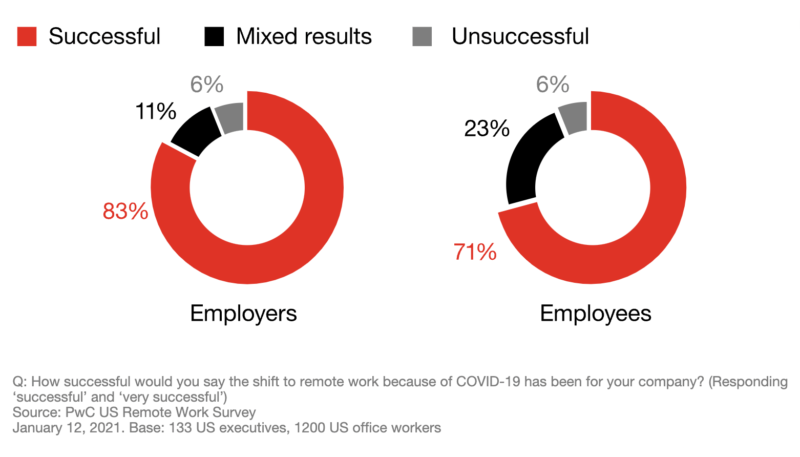
Workplace compliance is more important than ever in the post-pandemic workplace. With so many employees working remotely, organisations must have a plan in place to ensure their hybrid teams follow best practices and guidelines.
Since the pandemic’s outbreak, many organisations have been forced to adopt hybrid working models, with some employees working from home and others in the office, or all employees splitting their time between remote work and in-office work.
This setup has been a boon for both workers and employers. According to PwC’s US Remote Work Survey, 83% and 71% of employers and employees, respectively, believe their shift to remote work at the height of the pandemic was successful.
Source: PwC
Unsurprisingly, this success puts workers in a strong position to push for permanent flexible working arrangements. In 2021, Cloudbooking and YouGov surveyed US and UK workers and found that 64% of adults want a permanent mix of remote work, in-office work and working in an approved public space.
Related Reading: The Hybrid Working Model: What Is It and Can It Work?
Why hybrid work presents challenges to workplace compliance
But like any major change to the workforce, the shift away from the traditional workplace has created new challenges. In the case of a hybrid working policy, these challenges involve workplace compliance.
For instance, a 2020 report by software firm Navisite found that a third of companies they surveyed were not ready to shift to remote work during the pandemic, and half said they struggled with IT-related issues. Meanwhile, cyber exposure company Tenable found that nearly three in four (74%) organisations blame vulnerabilities in their remote work setups for increased exposure to cyber security attacks.
Related Reading: A Guide to Remote Work Cyber Security for Hybrid Teams
Cyber security, however, is just one risk area that could affect your hybrid workforce. Organisations must ensure that their hybrid teams follow guidelines and best practices to maintain a compliant workplace. Here are some tips to help you do just that.
1. Develop practical compliance policies
One of the simplest things you can do to increase the likelihood of hybrid workers following your policies and procedures is to consult them and understand their working practices. Instead of automatically chalking up issues like inadequate record-keeping and missed checks to laziness, your procedures could be to blame.
For example, a policy that’s too long or interrupts your workers’ daily activities will naturally have a low likelihood of being followed. The key is to integrate your compliance requirements into existing practices.
Related Reading: How to Improve Remote Working: Lessons From Lockdown
2. Ensure that all employees have easy access to the same resources and information
One of the common problems of corporate policies and procedures is that they’re often buried in long and inaccessible documents — typically presented when an employee is onboarded or when new rules are first implemented. When this happens, these policies end up being forgotten.
While formal documentation has a purpose, it’s just as important to make your policies and guidelines visible at all times. In hybrid work settings, this may require routine reminders from managers or automated messages on your intranet communications channels. For instance, desk booking or hoteling software can automatically send compliance or safety reminders to in-office workers.
3. Communicate workplace policies clearly to establish buy-in
Often, the importance of workplace compliance doesn’t quite make its way to an organisation’s workforce. Simple rules, like not using a personal device to send work emails, may seem like a minor thing to worry about for workers but can be vital to a company’s cybersecurity infrastructure.
Regular workplace training and refresher sessions on your policies and protocols will help your hybrid teams understand why you’re asking them to follow your rules and reinforce their importance.
4. Monitor workplace compliance
Lapses in workplace compliance are bound to happen, however hard you try to avoid them. A stronger approach might be necessary at this point. For example, activity logs or checklists that workers have to go through to confirm the completion of tasks can be ideal for sensitive processes. You can also use software to automate reporting of compliance data.
Despite being effective, monitoring should only be used where necessary — like critical processes that could affect worker health and safety. Aggressive surveillance could cause workers to feel they’re being micromanaged, leading to poor employee engagement.
Simplify workplace compliance and set up your hybrid team for success
As the workplace continues to evolve, so will your organisation’s compliance risk. Hybrid teams present a unique challenge when it comes to workplace compliance. On the one hand, you have employees who are in the office and are subject to traditional workplace rules and regulations. On the other hand, you have employees working remotely who may not be as familiar with these rules and regulations.
Follow these tips to ensure your hybrid workforce knows what’s expected of them and buy into the importance and benefits of your compliance policies.
Follow the Cloudbooking blog to get more insights on managing workplace compliance and employee engagement. Contact the Cloudbooking team to find out how our workspace management platform helps hybrid teams comply with workplace rules and protocols. Schedule an obligation-free demo to learn how our platform works.



